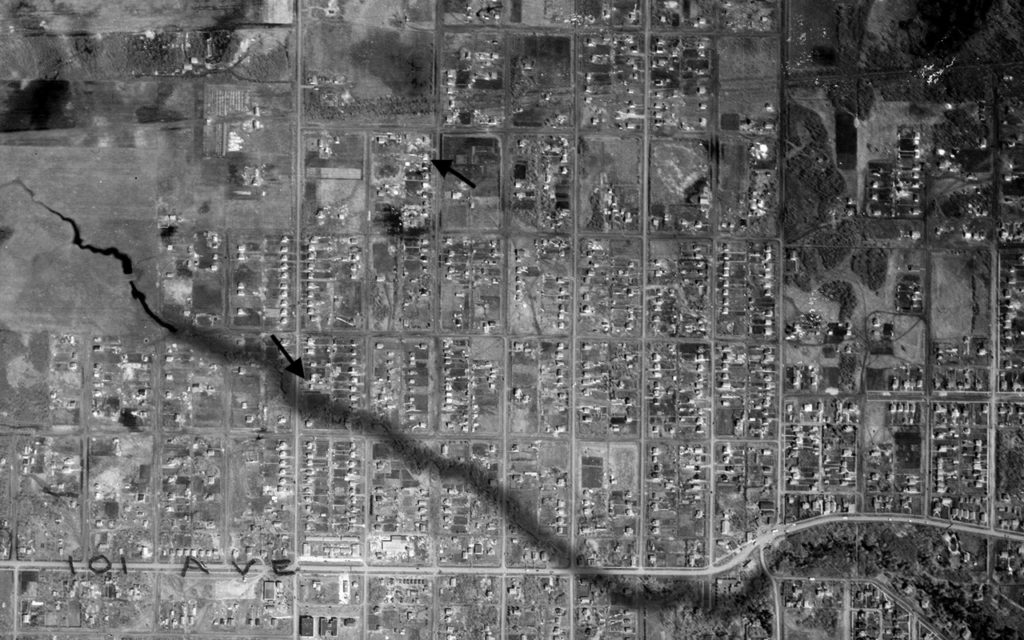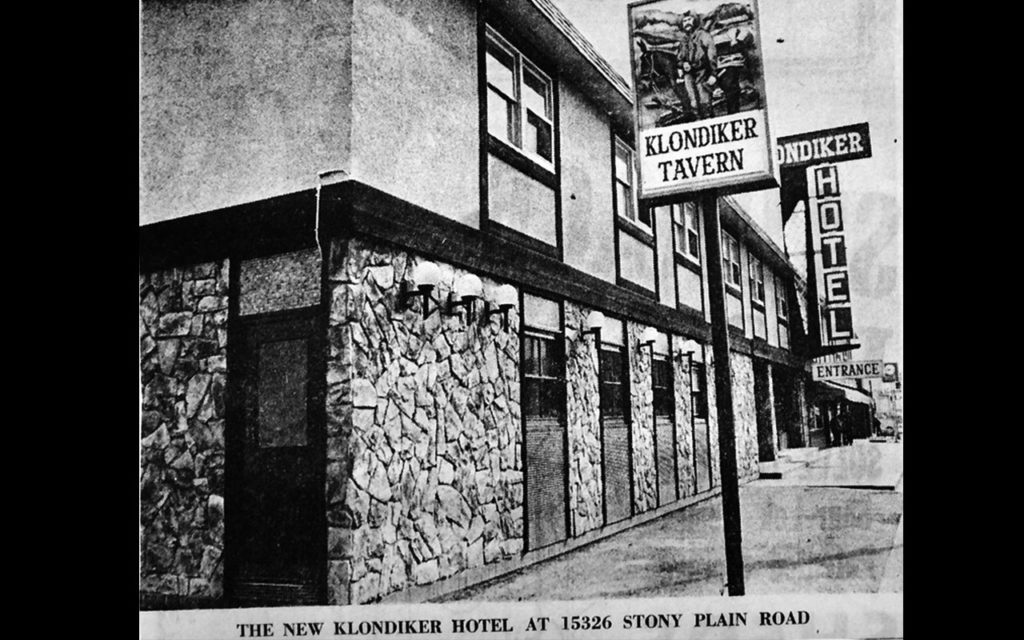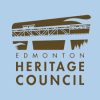Walter Touchings was interviewed by telephone for the Jasper Place Community History Project on January 24th, 2023. Barrie Touchings, his nephew, also interviewed by the JPCHP, was one of the interviewers. Walter Touchings was 95 years old at the time.
Walter Touchings was born in Radway, Alberta in 1928, and grew up on a farm in Thorhild that his family had cleared. Touchings left school at 16, and tried various kinds of work throughout Alberta, until he married in 1950 and settled in Edmonton, living in Jasper Place for a time at 152nd St. and 102nd Ave. in the garage behind the house in what is now known as a “secondary suite”. Later, he bought a house on 127th St. Here, we share some of his stories in snippets from the interview.
Q: Didn’t [your father] clear most of that quarter [in Thorhild] with an axe?
WT: Oh yeah, that’s all they had at that time. Mother was there. She said if she could’ve found a way out, she would’ve run. But she couldn’t because she didn’t know which way to go. It was all trees.
Q: What kind of house did they build?
WT: It was an all-log house. Three Swedes around there, they built them log houses. By the time they moved out there I guess that was just finished, that log house. Then later they built a kitchen on it. They put paper over the logs on the inside, so it looked better in there. The mice used to get in between the two logs. My brother used to take a 22 and shoot them when they poked their head out, so it was getting to smell pretty good in the back of that paper that was piled on there.
Q: What kinds of chores did you do?
WT: Chores? It was a steady job of chores. There was always something: to clean out the barns every day for cows, keep them in. In wintertime they had to be in all the time. We’d bring them out and water them at the well house, then get them back in again before they froze. The tits would freeze if you left them out too long. I can still remember one year having 60 below for a week at Christmastime. We didn’t do nothing, just get the cows out and water them, get them back in, milk and feed them. But the barns were always nice and warm because of all them animals in there. You’d usually have four feet of straw on top of the roof, so it kept the heat in pretty good. It was warmer in there than in the house.
Q: What kind of crops did you grow?
WT: Wheat, oats and barley, three different kinds of cereal grain. The wheat, we took that over to Radway to a flour mill over there. In the fall time dad would go over there and spend two days, one over and one back, and bring back the flour and the shards of the bran. That had to hold us for the winter for bread. Mother made bread all the time with that homemade flour. And we had lots of pigs to eat.
Q: [For your work], were you mostly welding?
WT: Yeah. I started welding in Northwest Industries. Well, I was welding in Redwater when I was there. I started apprenticing … in Western Welding down there. When they closed down, then I went to Edmonton and got on with Northwest Industries in the airport there. When they closed down, then I got on with Fruehauf Trailers and worked there for quite a few years. That’s where most of the guys from Fruehauf Trailers lived, over in Jasper Place. It was cheaper buying houses and starting out, so quite a few of us used to drive back and forth from out there.
Q: So you got a house in Jasper Place?
WT: I stayed with a fellow name of Swanson at about 152nd Street near the ravine there, to the north, maybe about 102nd Avenue, I guess. Swanson worked for the school board, and he had a garage out behind made into a suite. So, we stayed in that for two or three years. Then he retired and sold, and the ones that took over didn’t want anybody out there anymore. So I got a house then. There used to be a real estate guy on the corner of 149th and Stony Plain Road, an old-timer.
Q: Wasn’t there someone there by the name of Walker?
WT: Yeah, that’s possible. He sold me a piece of property over by the elevators, at the north end there about 127th Street. By the government elevators. They’re still there, I think.
Q: Was that just north of the tracks?
WT: Just north of the tracks. The old lady that lived in there with this guy, I guess she stayed there by the window and used to count the railroad cars that went back and forth there. That place was that close to the track. She’d do the old farm style of four marks with a slash through for five for the amount of cars she was counting.
Q: Tell us more about the time in Jasper Place when you were living in the garage.
WT: This guy had a garage, and he made it into a suite, half of it on the one side. There was just a kitchen and a bedroom. We used to have the water barrel in the bedroom and a guy would come with a hose and fill that barrel whenever we wanted water. If I wanted a telephone, I had to go to the house and use their phone. He was a maintenance man for the school division in Jasper Place until he retired from there. That was right down where St. Anne’s Church used to be. When you went through the ravine, St. Anne’s Church was up on the top there. It burnt there one day, and I don’t think they ever built it again.
Q: But you were just east of St. Anne’s Church, right?
WT: Yeah, right east of it. The big white house was the main house, then the garage to the east a little bit.
Q: I remember that as being a double lot.
WT: Yeah, I think it was. Even where the garage was, there was nothing between that and the ravine I don’t think.
Q: I’m trying to imagine where the ravine was.
WT: It was south of that 102nd Avenue.
Q: Was it part of the old MacKinnon Ravine?
WT: I don’t think it had a name. You just went off Stony Plain Road and started north, and then you went through that ravine. We were just on the north side of it there. After that I don’t know if there was much to the north there at all. I don’t know if it even went up north at that time very far.
Q: I think that ravine went west from there on about 102nd Avenue, over about as far as 156th Street.
WT: Yeah. Well, Bob was on 154th. That ravine had to be south of him there somewhere. There didn’t seem to be no dip going there, but we had a good one where I was at.

Q: How did you get to work?
WT: An old car. I think I had a ’38 Chev there. It was always my own vehicle. When I was at Fruehauf, the guys that worked there, a lot of them were out at Jasper Place so we used to run one car sometime. One guy would take it for a week and then another guy would haul for a week back and forth to work.
Q: What were the roads like?
WT: Roads? Well after you left 149th Street you didn’t have no roads; it was trails in there then. Like I say, I don’t remember driving too far north of where we lived at any time. I don’t know if there’s a road out that way or not.
Q: So, there was no gravel road?
WT: Oh no, no, just clay and mud. That Jasper Place was good clay.
Q: Was that garage suite a legal suite?
WT: No, it was just something to live in. There was no worries about legal then. You could’ve put a tent up anywhere and stayed out there, and they wouldn’t have known. We called that Dogpatch when we first went there. Anything west of 149th was Dogpatch.
Q: Did you do any shopping in Jasper Place when you lived there?
WT: We must’ve done some down there off Stony Plain Road. That was the only place to shop at that time that I can remember, close to where we were. I don’t remember what stores they were though.
Q: Do you remember where you got groceries?
WT: No, I don’t remember. It must’ve been just small stores. That big one didn’t come in there until years later. If you’ll remember, the city bus used to come up to just about ‘49th. He came up to about ‘48th and made a loop in there, a turn. Anybody from Jasper Place had to run down to that turn down there to catch the bus. That must’ve been 148th and Stony Plain Road, the south side of it.
Q: When you say there wasn’t much around when you headed north, was it farmers’ fields, or what kind of terrain?
WT: Seemed to me that was the end of the world back in there. I don’t know. I could never remember anything off that highway too much, off that Stony Plain Road, except little shops on that part down there. When did the hotel go in?
Q: In ’52. That’s the old Klondiker. Did you ever go to the Jasper Place Hotel at that time, before it became the Klondiker?
WT: We spent a lot of time in there. That was the only recreation you had then.
Q: Was there music there at the time? Were there groups that played?
WT: That wasn’t really a thing I don’t think at that time. I can’t remember them having too much at them bars for entertainment.
Q: In those days, did they still have the ladies and escorts section?
WT: Oh yeah, you couldn’t get in there. You had to have a lady to go with you to get into the escorts, otherwise you had to go by yourself. If you went by yourself, you couldn’t get over to the other side.

Q: What [were the neighbours] like when you lived in Jasper Place?
WT: The only ones I really knew of was east of us [on 151st Street]. He used to work in the coalmines. I can’t remember his name now. He had quite a few boys. He was dying of coal dust, the dad was. I can’t remember their names. But like I say, at that spot there wasn’t that many. There was just that house over to the east of us where they lived. They’d been there for years. I don’t know if it was beyond the ‘49th or not, but it seemed to me it was quite a ways over to their place. I don’t know, we never mixed too much. We’d work, come home, and go back to work again.
This post is part of the Jasper Place Community History Project’s Community Stories series. These are stories about current and former community members presented mostly in their own words. We have not fact-checked these stories. As a result, there may be some discrepancies concerning dates, locations, spellings of names, and other details.
The series is curated by Paula E. Kirman and Colette Lebeuf.


